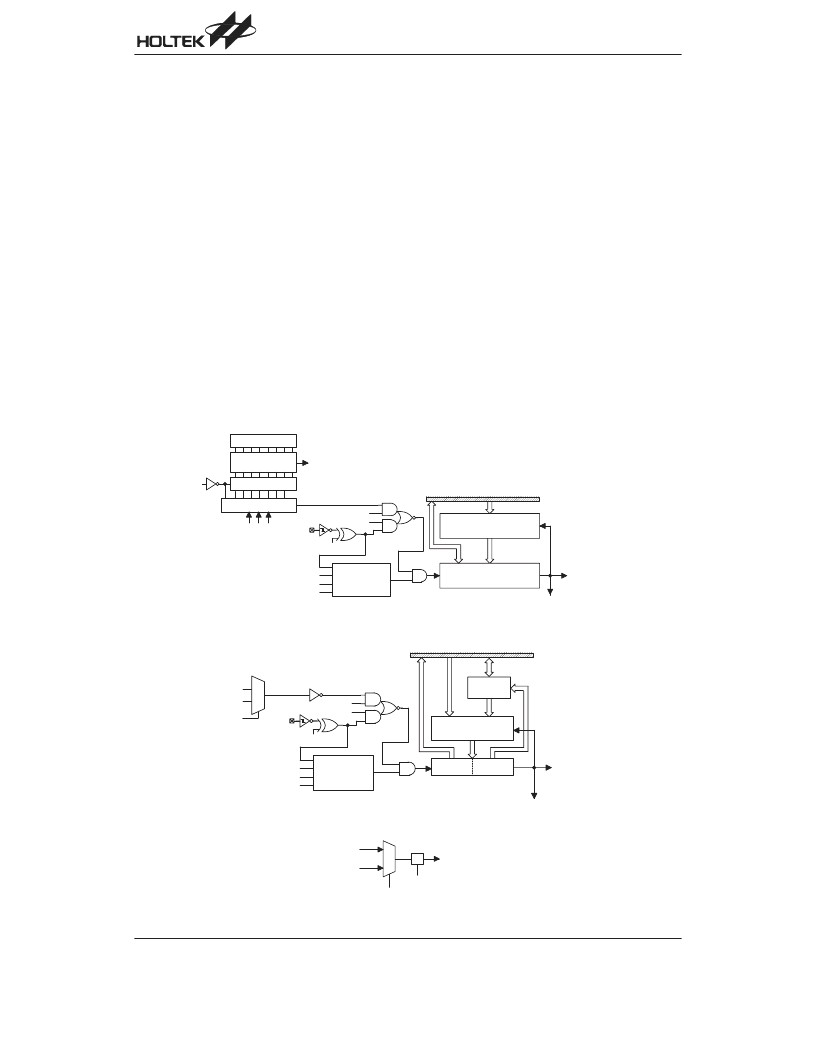- 您現(xiàn)在的位置:買賣IC網(wǎng) > PDF目錄385399 > HT46R64 (Holtek Semiconductor Inc.) A/D with LCD Type 8-Bit MCU PDF資料下載
參數(shù)資料
| 型號: | HT46R64 |
| 廠商: | Holtek Semiconductor Inc. |
| 英文描述: | A/D with LCD Type 8-Bit MCU |
| 中文描述: | 在A / D液晶型8位微控制器 |
| 文件頁數(shù): | 17/47頁 |
| 文件大小: | 345K |
| 代理商: | HT46R64 |
第1頁第2頁第3頁第4頁第5頁第6頁第7頁第8頁第9頁第10頁第11頁第12頁第13頁第14頁第15頁第16頁當(dāng)前第17頁第18頁第19頁第20頁第21頁第22頁第23頁第24頁第25頁第26頁第27頁第28頁第29頁第30頁第31頁第32頁第33頁第34頁第35頁第36頁第37頁第38頁第39頁第40頁第41頁第42頁第43頁第44頁第45頁第46頁第47頁

HT46R64/HT46C64
Rev. 1.40
17
September 21, 2004
Timer/Event Counter
Two timer/event counters (TMR0,TMR1) are imple-
mented in the microcontroller. The Timer/Event Counter
0 contains a 8-bit programmable count-up counter and
the clock may come from an external source or an inter-
nal clock source. An internal clock source comes from
f
SYS
. The Timer/Event Counter 1 contains a 16-bit pro-
grammable count-up counter and the clock may come
from an external source or an internal clock source. An
internal clock source comes from f
SYS
/4 or 32768Hz se-
lected by option. The external clock input allows the
user to count external events, measure time intervals or
pulse widths, or to generate an accurate time base.
There are two registers related to the Timer/Event
Counter 0; TMR0 ([0DH]) and TMR0C ([0EH]). Two
physical registers are mapped to TMR0 location; writing
TMR0 puts the starting value in the Timer/Event Coun-
ter 0 register and reading TMR0 takes the contents of
the Timer/Event Counter 0. The TMR0C is a timer/event
counter control register, which defines some options.
There are three registers related to the Timer/Event
Counter 1; TMR1H (0FH), TMR1L (10H) and TMR1C
(11H). Writing TMR1L will only put the written data to an
internal lower-order byte buffer (8-bit) and writing
TMR1H will transfer the specified data and the contents
of the lower-order byte buffer to TMR1H and TMR1L
registers, respectively.
The Timer/Event Counter 1 preload register is changed
everytime there is a writing operation to TRM1H. Read-
ing TMR1H will latch the contents of TMR1H and
TMR1L counters to the destination and the lower-order
byte buffer, respectively. Reading the TMR1L will read
the contents of the lower-order byte buffer. The TMR1C
is the Timer/Event Counter 1 control register, which de-
fines the operating mode, counting enable or disable
and an active edge.
The T0M0, T0M1 (TMR0C) and T1M0, T1M1 (TMR1C)
bits define the operation mode. The event count mode is
used to count external events, which means that the
clock source is from an external (TMR0, TMR1) pin. The
timer mode functions as a normal timer with the clock
source coming from the internal selected clock source.
Finally,thepulsewidthmeasurementmodecanbeused
to count the high or low level duration of the external sig-
nal (TMR0, TMR1), and the counting is based on the in-
ternal selected clock source.
6
7
& 6 A (
(
3
+
+
+
+
+
+
+
+
+
+
6
( '
%
(
6
4 5 @
(
-
7
(
6
(
4 5 @
(
-
7
(
;
+ <
( *
4 5
(
6
4 5 (
!
&
.
&
+
,
+
+
; 0 >
< (
( ; 1 >
<
'
(
+ -
-
-
(
Timer/Event Counter 0
3
+
+
6
( '
%
(
6
&
&
.
-
1 0 4 8 9
!
0 5 *
(
6
( *
6
7
& 6 A (
(
$
A ( * #
& &
*
8
% ( * #
$
A ( * #
0 5 *
(
-
7
(
Timer/Event Counter 1
!
-
3
3
(
(
"
(
(
$
3
+
3
PFD Source Option
相關(guān)PDF資料 |
PDF描述 |
|---|---|
| HT46R23 | 8-Bit OTP Microcontroller |
| HT46R47 | 8-Bit OTP Battery Charger Controller |
| HT46R65-100 | A/D with LCD Type 8-Bit MCU |
| HT46C65 | A/D with LCD Type 8-Bit MCU |
| HT46C65-100 | A/D with LCD Type 8-Bit MCU |
相關(guān)代理商/技術(shù)參數(shù) |
參數(shù)描述 |
|---|---|
| HT46R64_06 | 制造商:HOLTEK 制造商全稱:Holtek Semiconductor Inc 功能描述:A/D with LCD Type 8-Bit MCU |
| HT46R64_11 | 制造商:HOLTEK 制造商全稱:Holtek Semiconductor Inc 功能描述:A/D with LCD Type 8-Bit MCU |
| HT46R65 | 制造商:HOLTEK 制造商全稱:Holtek Semiconductor Inc 功能描述:A/D with LCD Type 8-Bit MCU |
| HT46R65_11 | 制造商:HOLTEK 制造商全稱:Holtek Semiconductor Inc 功能描述:A/D with LCD Type 8-Bit MCU |
| HT46R65-100 | 制造商:HOLTEK 制造商全稱:Holtek Semiconductor Inc 功能描述:A/D with LCD Type 8-Bit MCU |
發(fā)布緊急采購,3分鐘左右您將得到回復(fù)。